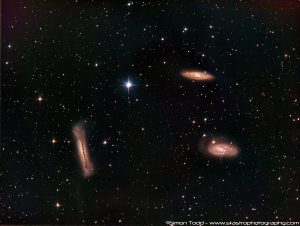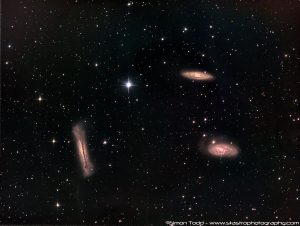 This is not the first time I have imaged this trio of trespassers, I have imaged them before on the same scope but with my previous Atik 383L+ CCD Imager, so again similar to M81 and M82, you can clearly see the difference in resolution the new camera offers, here’s the previous image taken from my previous post here:
This is not the first time I have imaged this trio of trespassers, I have imaged them before on the same scope but with my previous Atik 383L+ CCD Imager, so again similar to M81 and M82, you can clearly see the difference in resolution the new camera offers, here’s the previous image taken from my previous post here:
Equipment Used:
Imaging Scope: Sky-Watcher Quattro 8″ F4 Imaging Newtonian
Imaging Camera: Qhyccd 183M 20mpx ColdMOS Camera at -20C
Guide Scope: Sky-Watcher Finder Scope
Guide Camera: Qhyccd QHY5L-II
Mount: Sky-Watcher EQ8-Pro GEM Goto Mount
Filterwheel: Starlight Xpress Ltd 7x36mm EFW
Filters: Baader Planetarium 36mm LRGB Filters
Software:
Image Acquisition: Main Sequence Software SGPro 3
Guiding: PHD2
Image Processing: PixInsight
Image Details:
Luminance: 101×150 Second Exposures
Red: 101×150 Second Exposures
Green: 101×150 Second Exposures
Blue: 101×150 Second Exposures
Acquisition Dates: 18/19/20/21 Apr 2018, 4/5/6/7/8/9 May 2018
Total Exposure Time: 16.83 Hours
Target Details: Leo Triplet
Constellation: Leo
RA: 11h 19m 36.15s
Dec: 13° 17′ 2.90″
Distance from Earth: 35 Million Light Years
Galaxies: M65 (Top Right), M66 (Bottom Right) and NGC3628 (Bottom Left) also known as The Hamburger Galaxy or Sarah’s Galaxy





